Reintroduction of the Brown Trout in Armenia’s Rivers Studied by AUA Acopian Center for the Environment
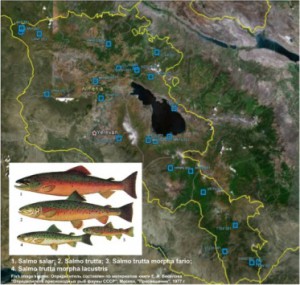 Overfishing in the 1990s has led to a collapse of Brown Trout (Salmo trutta morpha fario) stocks throughout Armenia. This species, once available abundantly in all of Armenia’s provinces, is currently found in fewer than 20% of surveyed rivers. To determine the suitability for its reintroduction, the AUA Acopian Center for the Environment with support from GIZ, the German Organization for International Cooperation, has conducted an extensive survey of physical and chemical properties of 22 rivers and streams in 7 provinces of Armenia.
Overfishing in the 1990s has led to a collapse of Brown Trout (Salmo trutta morpha fario) stocks throughout Armenia. This species, once available abundantly in all of Armenia’s provinces, is currently found in fewer than 20% of surveyed rivers. To determine the suitability for its reintroduction, the AUA Acopian Center for the Environment with support from GIZ, the German Organization for International Cooperation, has conducted an extensive survey of physical and chemical properties of 22 rivers and streams in 7 provinces of Armenia.
“The results of the survey are promising,” says Dr. Karen Aghababyan, chief scientist of the AUA Acopian Center and the study’s principal investigator. “Most rivers studied are suitable for reintroduction of the species. Their oxygen and pH levels were within the range preferred by the Brown Trout, and most sites had appropriate levels of ammonia and carbon dioxide, as well as enough benthic invertebrates to serve as food for the reintroduced fish,” explains Dr. Aghababyan.
In addition to scouting river sites, the AUA Acopian Center researchers found an appropriate brood stock with which to populate the rivers in question. To this end, the Center has collaborated with a fish farm that had Brown Trout captured wild in the Arpa River in 2009. This trout, which has not interbred with other fish species and has not gone through artificial selection, caries all the genes of the wild population and is suitable for introduction into the native stocks.
For many decades, the Brown Trout has been a staple fish in diets worldwide. In most parts of the world, Brown Trout is interbred with local populations, resulting in fish that is genetically different from their ancestors. Very few places on Earth are home to genetically pure Brown Trout. Armenia is one of these places, its mountainous rivers providing protection from interbreeding with non-indigenous species.
A successful reintroduction of a fish species needs more than adequate water conditions and pure breed. “We also need to ensure that the site is protected from poachers. Communities close to these fish populations have to have economic incentive to protect them. Local stewardship of the fish stock has to be worked into the reintroduction,” says Dr. Aghababyan.
Batumi Raptor Count and AUA Acopian Center Continue to Partner
AUA Acopian Center for the Environment continues its cooperation with the Batumi Raptor Count (BRC) by developing and delivering environmental education programs to youth from all parts of the Caucasus. This year, Hasmik Ter-Voskanyan (in August) and Siranush Tumanyan (in September) led youth groups, including some from Armenia.
In early September, Dr. Karen Aghababyan, AUA Acopian Center chief scientist, attended the International Batumi Bird Festival organized by BRC. During his visit, Dr. Aghababyan discussed opportunities for expanding cooperation between the organizations through development of nature-based tourism as well as strengthening environmental-education and bird-monitoring programs.
“This is a relationship we want to develop further,” says Alen Amirkhanian, director of the AUA Acopian Center. “Batumi provides an unparalleled setting in the Caucasus to educate and conduct research on the environment. Importantly we are able to do this jointly with people from all parts of the Caucasus and Europe. Developing this type of cooperation is essential for addressing environmental protection needs,” says Amirkhanian.
BRC is a vital nature conservation program in the region. It monitors the more than 850,000 birds of prey that migrate through the “Batumi Bottleneck” every fall. It also works to protect the birds from illegal shootings and trappings, practices that continue to this day.
Batumi is a Black Sea coastal city in the Ajara region of the Republic of Georgia.
Duration: 2005-present
Acopian Center for the Environment (ACE)
Participants: ACE staff and invited volunteers
The AUA Acopian Center for the Environment in cooperation with volunteers and enthusiasts from different fields, organized winter bird count in Yerevan Botanical garden.
Botanical garden is one of the largest green territories in Yerevan city with half-wild oases. There are several notable species of birds breeding there, such as Levant Sparrowhawk, Hobby, Long-eared Owl, Syrian Woodpecker, Golden Oriole, Common Nightingale, Greenfinch etc. Food availability compels winter bird species to come down and stay in the garden during the winter.

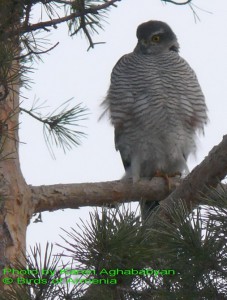
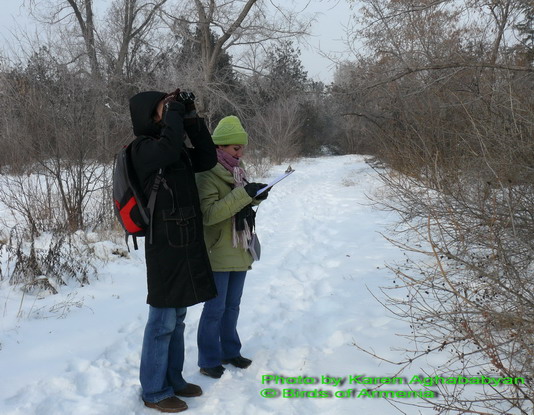
The main aim of the count is to monitor:
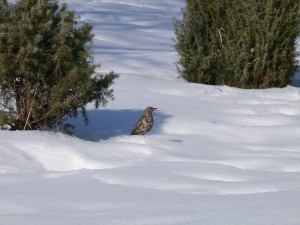

We have been organizing annual winter bird count in Botanical garden starting from 2005. It lasts for about three months from the end of November till the end of December, and is conducted ones a week. Every count day in early morning we pass the same route with 1km length, during this we record all encountered bird species, their number, the approximate distance between the bird and observer, angle, height and their behavior. After passing the main count route we explore other parts of the territory for the species, which have been possibly missed earlier.
After several years it will be possible to analyze some details depending on winter birds in Yerevan and analyze the effectiveness of linear count in comparison with diffusion watch and count.
This count gives us an opportunity to record strictly wintering bird species such us Redwing, Fieldfare, Common Goldcrest, European Siskin, etc.
Participation in winter bird count is a good experience for beginners: “Bird Identification Training”’ (ACE) students, student-zoologists and enthusiasts, who are interested in birds. This gives them an opportunity to study linear bird count technique and to improve bird identification skills. Every year about 8-12 young people join our winter bird counts.

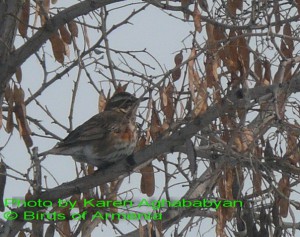
List of recorded bird species in Botanical garden
(2005 – 2009)
Duration: 2005-2006
Acopian Center for the Environment
Yerevan State University
In 2005 we have started a pilot survey of raptors at the forest area of AragatsMountain. We would like to find out possibilities of long term monitoring of raptor species. One of the main objectives of the project was the practical independent research education of the students of YerevanStateUniversity and PedagogicalUniversity. All the work of the field year of 1995 was performed by the BA last year students Maro Kochinyan and Hayk Harutyunyan. They were assisted by a couple of younger students and several volunteers of the “Birds of Armenia” project. The research was done under the direct supervision of senior scientific researcher Karen Aghababyan. In the course of the research 6 long term field trips were held in the research region.

Forest area of Aragats mountain
The forest area of Aragats is rather small but includes nearly all diurnal forest raptor species found in Armenia.
Particularly we found the following species:
| Honey Buzzard Pernis apivorus – 1*
*quantity is given in pairs | Nestlings of Common Buzzard (Buteo buteo)
|
Below is the copy of article published in Russian Conservation News No.39 Summer 2005
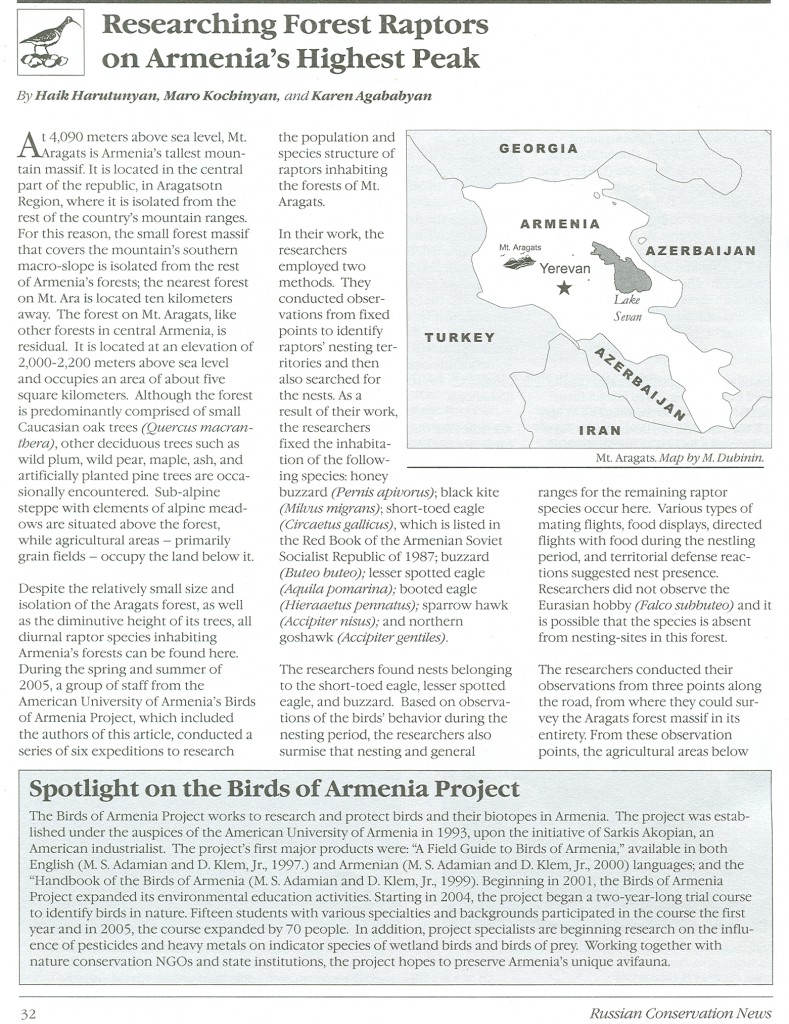
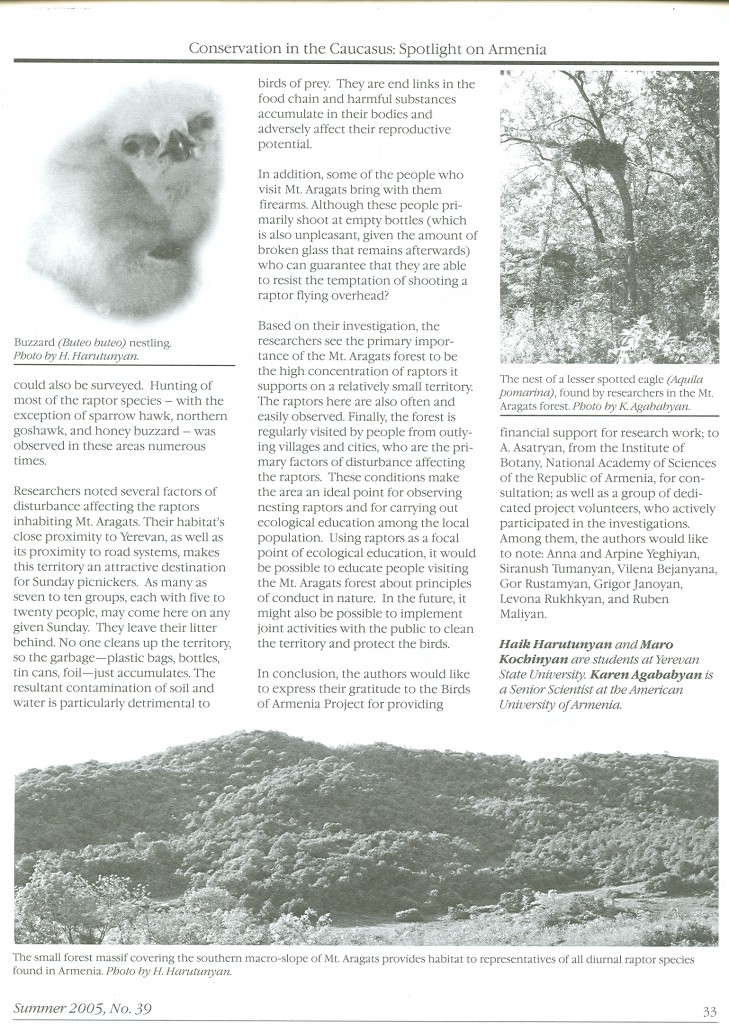
Duration: 2006-2008
Acopian Center for the Environment
Yerevan State University
State Pedagogical University
Birds of prey are excellent environmental indicators and flagship species for natural-resource conservation. Increasing of Armenian agriculture and other blanches of industry can have a negative impact to environment. To track the possible influence of industry to our nature we would like to start monitoring of subpopulations of model species in some regions of Armenia.
As a species to be monitored we have chosen Long-legged Buzzard (Buteo rufinus) because it is most common rodent-eating bird that breeds in whole Armenia.
It will include mapping of nests, and survey of reproductive success. In 2006 we will conduct a pilot survey to see how many nests we can find.
Then in 2007 and later on we will investigate their feeding, reproductive success and analyze collected data on GIS Arc View.
The project will include education of local inhabitants about importance of rodent-eating raptors for agriculture and nature ecosystems.
The surveys were conducted by students, who have completed BITC courses in AcopianCenter for the Environment.

Long-legged Buzzard Buteo rufinus, outskirts of Gusana village, Shirak region of Armenia, Sep 9 2005.

Distribution map of the Long-legged Buzzard Buteo rufinus in Armenia
Results:
The Long-legged Buzzard (hereinafter LLB, Buteo rufinus) in Armenia was studied during 2006-2008 in frames of general bird survey trips and special trips aimed searching of the LLB nests. The study area covers some districts in central part of Armenia. The distances between the nests (nearest neighbour distance) vary in different regions of Armenia: in Vedi district the mean distance is 1.98±0,19km (n=10) while in Vayots Dzor region the mean distance is 3.04±0.3km (n=5); t=3.14, p=0.008. The difference in density seems correlated with steepness of surrounding area, since the Vedi district is generally more flat, than the Vayots Dzor region, which indicates that probably LLB prefer habitats with less steepness of slopes. Most probably it depends on hunting technique of LLB, which catches the prey on the ground dropping down from 5-10m. The other limiting factor is cliff availability, since in Armenia LLB breeds only on cliffs. Although LLB does not show dependence on the height of the cliffs and can place the nest on the height from 2 to 30m, it does not breed on trees, like in some parts of its area in Siberia.
The concluding results of the studies will be presented as an article on the International Raptor Conference in autumn 2009 in Switzerland.

In the frames of the study a GIS shape file was developed, covering all cliffs and rocky massifs of the entire territory of Armenia.
Relevant publication:
Some habitat preferences of Long-legged Buzzard (Buteo rufinus) in Armenia
Hovanisyan, T., Janoyan, G., Schaefer, M., Aghababyan, K.
Duration: 2008
Acopian Center for the Environment (ACE)
Participants: ACE staff and volunteers
Meghri forestry administration
The AUA Acopian Center for the Environment with the support of Peregrine Fund and Hawk Mountain Sanctuary in 2008 have conducted a survey of Peregrine Falco in Meghri district.
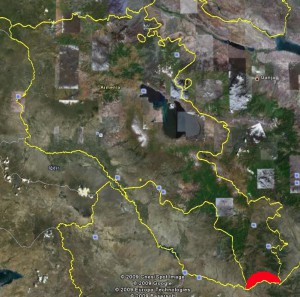 | 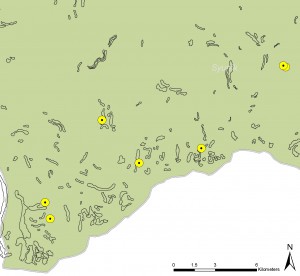 |
| Red field – study area | Peregrine nest sites |
Objectives:

Peregrine Falcon оn the nesting cliff
Results:
Two long term field trips were organized to the Meghri region, during March and May 2008.
We visited six known nest sites and three assumed ones.
For all of the observed breeding territories various parameters were recorded, such as GPS data, habitat description, elevation a.s.l., slope and aspect, and the height above the ground for the nests, behavior of breeding birds, nestlings and fledglings, food resource, Peregrine competition with other raptors. A number of birds, nests and biotope photos were taken.


Peregrine Falcon nesting cliffs in the semidesert and forest areas
From all the six known Peregrine nests in Meghri region only one successful pair with two fledglings were found, one site was occupied with two adults, but there were no young, and another site with only one adult bird. All other sites were unoccupied.
Analyzing these data and comparing it with previous ones the decline of Peregrine population in Meghri region becomes obvious. We assume that the main reason for the decline is the poisoning, such as sedimentary reservoirs of the copper, molybdenum and gold mines; use of pesticides for agriculture; forest management in frames of pest control.
During the whole project we worked with the local people from Meghri forestry administration and local enthusiasts. This co-operation helped us to do the data collection more effectively and to explain some details about poisoning and poaching.
Two articles on Peregrine Falcon research results are in process of publication.
 |  |
| Peregrine Falcon | Meghri forestry administration |
Table 1. Peregrine Falco in Meghri region, breeding pairs
| Lehvaz FPLGVZ1 | Meghri FPMGR1 | Agarak FPAGR1 FPAGR2 | Gravi Dzor FPGRV1 | Burtinqar FPBRT1 FPBRT2 | Nyuvadi AXNVD1 |
| 1996 | 3 nestling FPAGR1 | |||||
| 1997 | 4 nestling FPAGR1 | |||||
| 1998 | empty | 3 nestling | 3 nestling FPAGR2 | |||
| 1999 | ||||||
| 2000 | empty | 4 nestling | 4 nestling FPAGR2 | 3 juv. | ||
| 2001 | empty | 3 nestling | 2 ad | 2 ad | ||
| 2002 | 2 nestling | 2 ad | ||||
| 2003 | 2 ad | 2 ad | 2 ad | 2 ad | ||
| 2004 | 2 ad | 2 ad | 2 ad | |||
| 2005 | ||||||
| 2006 | ||||||
| 2007 | 4 nestling | |||||
| 2008 | 1 ad 0 nestling | 2 nestling | empty | empty | 2 ad 0 nestling | empty |
| 2009 | 2 ad 0 nestling | 3 nestling | empty | voice of ad |
During the Peregrine Falcon survey we also collected data about Bearded Vulture and Eurasian Griffon nests and breeding success. Comparing data on Griffon with previous ones, increase in breeding pairs and fledglings has been found in some colonies. Also one new colony was found. Bearded Vulture population remained stable.
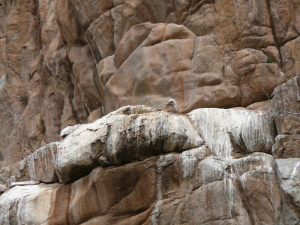 |  |
Adult Griffon on the nest | Griffon Vulture |
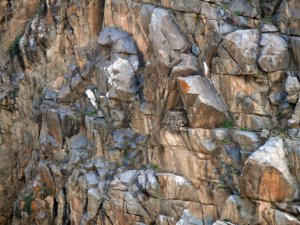 | |
Bearded Vulture | Bearded Vulture nest |
The Lesser Spotted Eagle (Aquila pomarina) inhabits almost all deciduous forest regions of Armenia. Some fragmental data regarding distribution and abundance of the species were collected in different periods (Leister and Sosnin 1942, Dal 1954, Adamian and Klem 1999) and the breeding biology was studied on the pare in Khosrov Nature Reserve (Geylikman, Hunanyan 1975). Due to economic and energy crisis and following economic growth in Armenia from 1990-s until now the land use pattern and the forest management in Armenia was strongly altered. The mentioned factors might have a negative impact on the large forest raptor species since they are more vulnerable and sensitive to changes in their habitat. Considering that the following objectives were chosen for particular study: (1) to refine knowledge on distribution and abundance of Lesser Spotted Eagle in Armenia; (2) to study habitat preferences of the species; (3) to identify current and potential threats for the species.
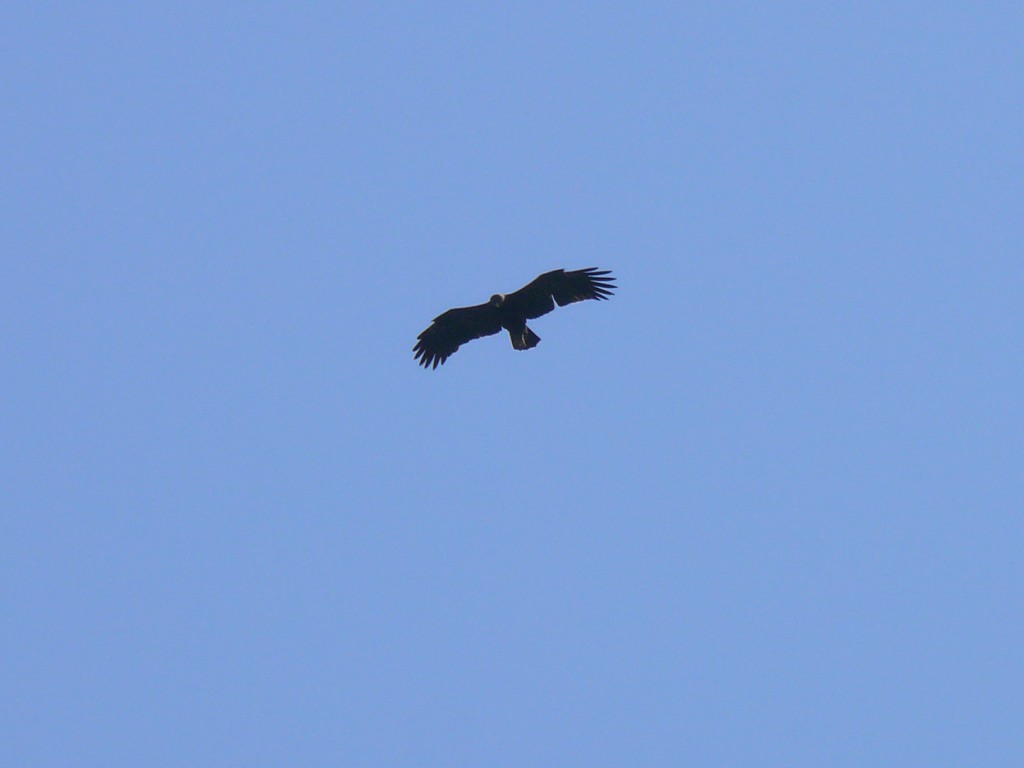
Foraging Lesser Spotted Eagle
Results
Based on the data collected during 1998-2007 it was possible to conclude the following:
1. Distances between neighboring nests are 14. 2 and 14. 3 km (based on 4 nests)
2. The average distance between the nest and limits of the hunting territory of a pair is 4. 05±0.39 km (n = 15, P<0. 05)
3. The average percentage of the forest cover within the species’ home range is 26. 07±3. 89 % (n = 15, P<0. 05);
4) There is a correlation between percentage of forest cover within the home range and the distance from the nest to the limits of hunting territory of Lesser Spotted Eagle (RPearson = 0. 548, P<0. 017)
5) The correlation can be described by the linear regression model (R = 0.548, F=5. 581, P<0. 034).
Extrapolation of these data for the rest of appropriate species’ habitats in Armenia outcomes in the maximum possible population size of the species in the country, which preliminary can be estimated as about 48-52 pairs.
The species in Armenia is facing to a number of direct and indirect threats, such as lack of enforced regulation in use of pesticides, poaching, human disturbance during breeding season and habitat loss.
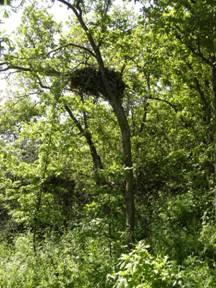
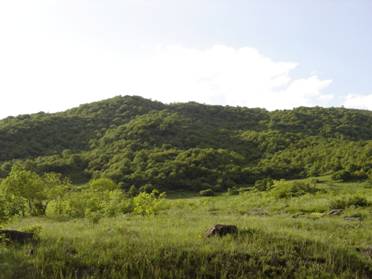
Habitat of the Lesser Spotted Eagle(left) and its nest on the oak tree(right)
Outcomes
1. The article regarding the subject was published. K. Aghababyan, V. Ananian, S. Tumanyan. 2008. To the Distribution and Abundance of Lesser Spotted Eagles in Armenia. // Research and Conservation of the Greater and Lesser Spotted Eagles in Northern Eurasia. Materials 5th Conference on Raptors of Northern Eurasia Ivanovo, February 4-7, 2008
2. Two amateur ornithologists (Sirnush Tumanyan and Tatevik Tamazyan) were trained in data collection and analysis and one of them, a student of Biological Department of Yerevan State University defended Master’s Thesis on the subject “To ecology of Lesser Spotted Eagles in Armenia”
3. The results of the project were used for the new edition of the Red Data Book of Armenia and would be useful for the future forest management planning and environmental assessment procedures.
Duration: 2009
ACE (American University of Armenia, Yerevan, Armenia)
ACCL (Hawk Mountain Sanctuary, PA, USA)
The AUA Acopian Center for the Environment in cooperation with Acopian Center for the Conservation Learning (Hawk Mountain Sanctuary) in 2009 conducted a pilot nest survey of Levant Sparrowhawk – one of the least known Western Palearctic raptors.
Several long term trips were organized to Aragats Mt and Meghri area, Yerevan city parks were surveyed as well on a frequent basis.
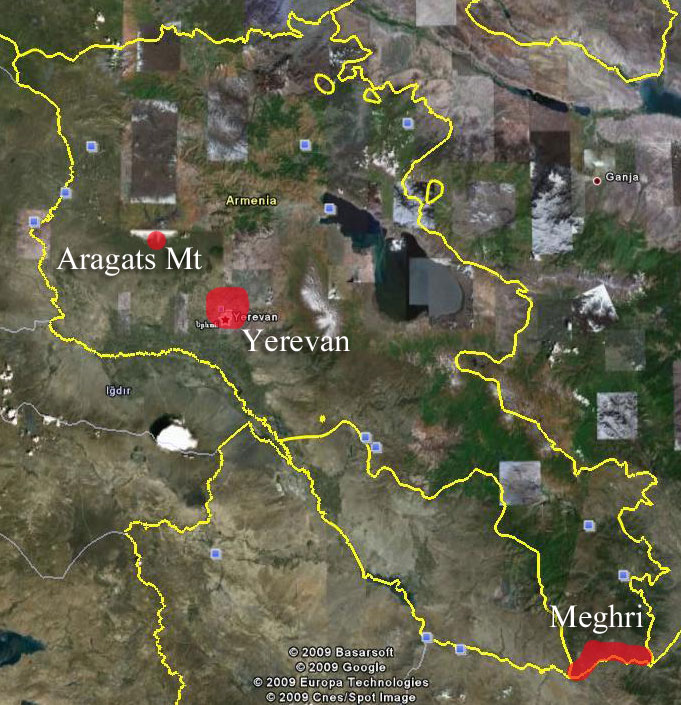
Red fields – study areas
Field trips took substantial part of the project during April – August.
The main aims of the survey were:
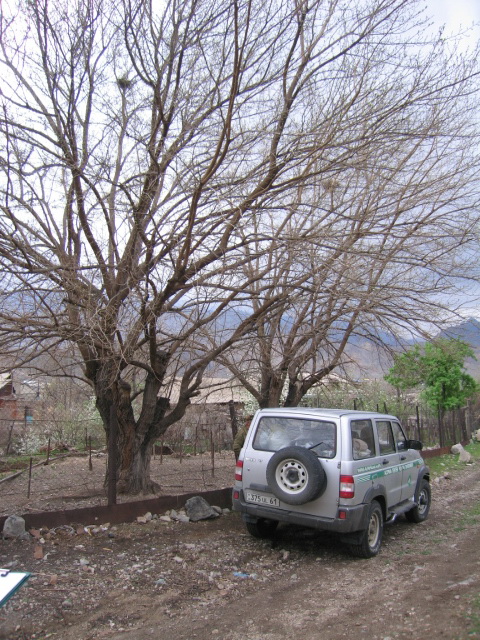


The surveys have successfully resulted in overall 17 breeding sites/pairs:
1. Aragats Mt slopes. No nest found and no territorial pair observed here in 2009.

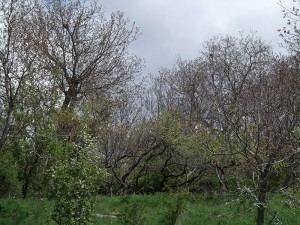
2. Yerevan city. 6 breeding sites found, of which:
a) one nest was lost because of the strong wind;
b) one nest wasn’t found, but a male and a female were showing a strong territorial behavior at a putative breeding site;
c) one nest with three chicks;
d) one – with 4 chicks;
e) two nests with two chicks.

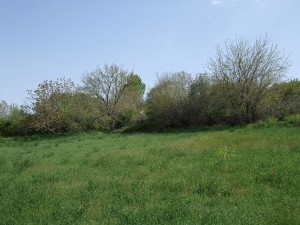
3. Meghri valley. 11 nests found in this area represent the highest known breeding density in Armenia.

Due to some circumstances there were missed fledging events for four of the 11 nests – it is not known how many chicks produced each of these four nests. As for the others:
a) four nests hold 2 chicks each;
b) three nests – 3 chicks in each.

During the surveys a nest searching technique was developed and tested as most suitable from few other methods tried.

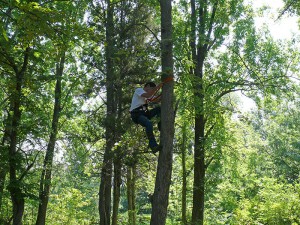
For all of the surveyed sites and nests there were recorded various parameters, such as nesting site GIS data, habitat description, behavior of breeding birds, nestlings and fledglings, interaction with other species and various other ecological information. Data on food was collected and taken few video footages and a number of photographs.

The information collected in 2009 helped to achieve initial objectives of the pilot project and will significantly contribute to the future surveys of the Levant Sparrowhawk in Armenia.
*************************************************************
During the Levant Sparrowhawk surveys we were granted with the discovery of a closely related Shikra (Accipiter badius), two pairs of which were found breeding for the first time in the country.


